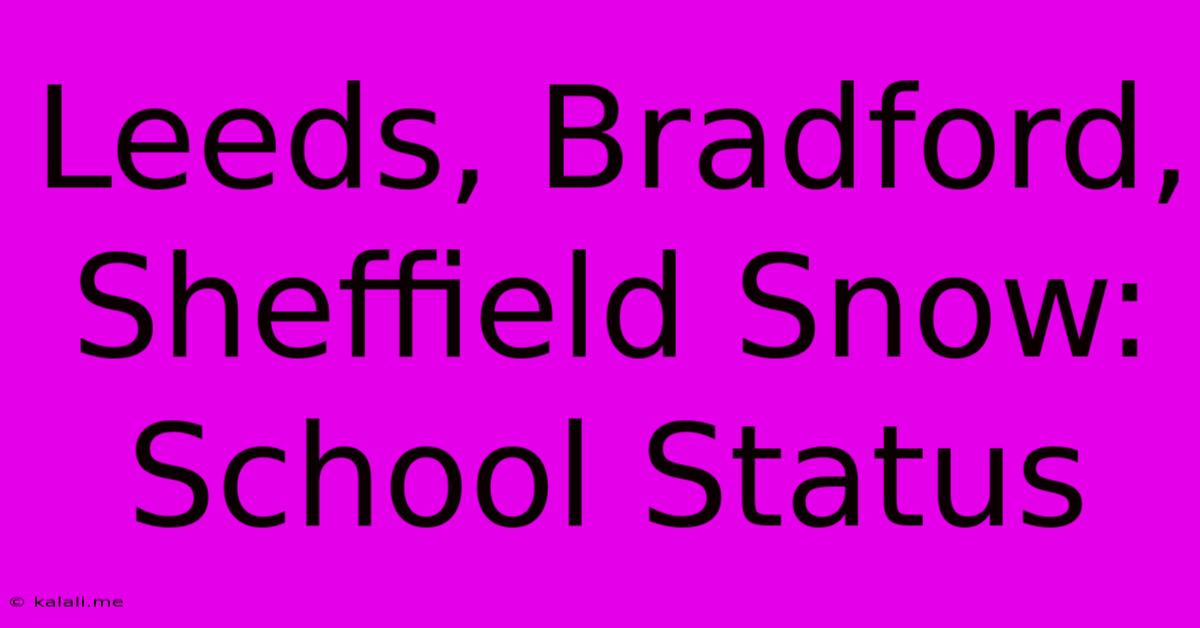Leeds, Bradford, Sheffield Snow: School Status
Kalali
Jan 10, 2025 · 4 min read

Table of Contents
Leeds, Bradford, Sheffield Snow: School Status & The Impact of Winter Weather
The unpredictable British weather often throws a spanner in the works, and nowhere is this more keenly felt than during periods of heavy snowfall. For parents in Leeds, Bradford, and Sheffield, the question of school closures due to snow is a yearly concern, impacting daily routines and childcare arrangements. This comprehensive guide will explore the factors influencing school closure decisions in these Yorkshire cities during snowy periods, outlining the processes involved and offering advice for staying informed.
Understanding School Closure Decisions in Snow
The decision to close a school due to snow isn't taken lightly. Local authorities, in conjunction with individual schools, carefully weigh various factors before making an announcement. These include:
1. Severity of Snow and Ice:
This is the most crucial factor. The depth of snow, its consistency (powdery snow presents different challenges to heavy, wet snow), and the presence of ice on pavements and roads all significantly influence the decision. A light dusting might not warrant closure, whereas a significant snowfall accompanied by icy conditions would almost certainly necessitate it.
2. Travel Conditions:
The safety of pupils and staff traveling to and from school is paramount. Impassable roads, treacherous pavements, and difficulties with public transport all contribute to the decision-making process. Local authorities often monitor road conditions closely, relying on reports from highways teams and weather forecasts.
3. School Accessibility:
Even if roads are passable, the school building itself might be inaccessible. Heavy snow can block entrances, make car parks unusable, and impede access for those with disabilities. The ability to safely and effectively clear the school grounds is also considered.
4. Staff Availability:
Snow and ice can significantly impact staff attendance. If a substantial number of teachers or support staff are unable to reach the school due to travel difficulties, closure may be deemed necessary to ensure the safe and effective operation of the school.
5. Risk Assessment:
Schools carry out detailed risk assessments before making any decision regarding closure. These assessments consider all the aforementioned factors, aiming to minimize risks to pupils and staff. Health and safety regulations play a vital role in these assessments.
How to Stay Informed About School Closures
Staying informed about school closures in Leeds, Bradford, and Sheffield during periods of heavy snowfall is crucial. Several avenues provide timely and reliable information:
1. Local Authority Websites:
Each local authority (Leeds City Council, Bradford Metropolitan District Council, Sheffield City Council) maintains a dedicated website section providing updates on school closures. These websites often feature searchable databases allowing parents to check the status of their child's school quickly and easily.
2. School Websites and Communication Systems:
Many schools utilize their own websites and communication systems (e.g., email, text messaging, apps) to directly inform parents about closures. Checking school websites regularly and ensuring contact details are up-to-date is essential.
3. Local News and Media:
Local news outlets (television, radio, and online news websites) typically provide updates on school closures during significant snowfall events. These reports often aggregate information from various sources, providing a comprehensive overview.
4. Social Media:
Social media platforms (Twitter, Facebook) can also be useful, although it's crucial to rely on verified sources and official announcements rather than unconfirmed rumours. Many schools and local authorities utilize social media to disseminate information quickly.
The Impact of Snow on School Life
School closures due to snow have several cascading effects:
1. Disruption to Education:
The most immediate consequence is the disruption to the normal educational schedule. Lost teaching time can impact learning and assessment, requiring adjustments to catch up on missed work.
2. Childcare Challenges:
For working parents, school closures present significant childcare challenges. Finding alternative childcare arrangements at short notice can be stressful and costly.
3. Community Impact:
Snow closures can have a wider community impact, affecting businesses that rely on school-age children, such as after-school clubs or local businesses near schools.
4. Economic Considerations:
Repeated school closures due to snow can have economic implications for families and businesses. Lost wages, additional childcare costs, and reduced productivity all contribute to these wider impacts.
Preparing for Snowy Conditions:
Proactive preparation can help mitigate some of the disruptions caused by snow:
1. Check School Communication Channels:
Regularly check school websites, emails, and text messages for updates.
2. Plan for Childcare:
Have backup childcare arrangements in place in case of a closure.
3. Prepare for Travel:
Ensure you have warm clothing, suitable footwear, and any necessary medications for journeys during snowy conditions.
4. Check Weather Forecasts:
Monitor weather forecasts to anticipate potential snowfall and plan accordingly.
5. Emergency Supplies:
Keep a supply of essential items at home, such as food, water, and medications, in case of power outages or travel difficulties.
Conclusion: Navigating the Winter Weather
Snowfall in Leeds, Bradford, and Sheffield inevitably causes disruptions, but by staying informed and prepared, parents can minimize the impact on their families and children’s education. Understanding the factors involved in school closure decisions and utilizing the various information channels available empowers parents to navigate these challenging winter periods effectively. Remember that the safety of children and staff is always the paramount concern, and closures are implemented as a precautionary measure to ensure everyone's wellbeing.
Latest Posts
Latest Posts
-
Ice Cream Flavors That Start With E
Jun 30, 2025
-
How Much Does A 30 Pack Of Beer Weigh In Pounds
Jun 30, 2025
-
How Long Is 22 Miles In Minutes
Jun 30, 2025
-
Out Of Department Custody By Court Order
Jun 30, 2025
-
Folder Is To Document As Envelope Is To
Jun 30, 2025
Related Post
Thank you for visiting our website which covers about Leeds, Bradford, Sheffield Snow: School Status . We hope the information provided has been useful to you. Feel free to contact us if you have any questions or need further assistance. See you next time and don't miss to bookmark.